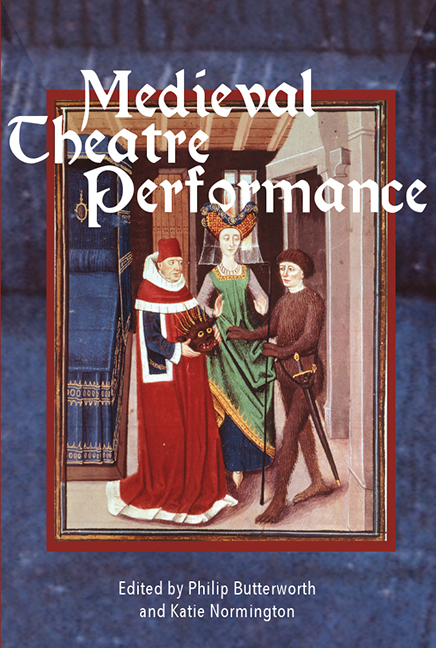Book contents
- Frontmatter
- Dedication
- Contents
- List of Illustrations
- Contributors
- Abbreviations of Principal Sources Cited
- Introduction
- Synopses
- 1 From Archive to Repertoire: The Disguising at Hertford and Performing Practices
- 2 Walk, Talk, Sit, Quit? On What Happens in Netherlandish Rhetoricians’ Plays
- 3 Performing Intrusions: Interaction and Interaxionality in Medieval English Theatre
- 4 Player Transformation: The Role of Clothing and Disguise
- 5 Pavilioned in Splendour: Performing Heaven in Fifteenth-Century Florence
- 6 Living Pictures: Drama without Text, Drama without Action
- 7 Performer-Audience Relationships in Fifteenth- and Sixteenth-century Danced Spectacles
- 8 Decadance in the Late Middle Ages: The Case of Choreomania
- 9 Writing, Telling and Showing Horsemanship in Rhetoricians’ Farce
- 10 Inanimate Performers: The Animation and Interpretive Versatility of the Palmesel
- 11 ‘lyke unto a lyvelye thyng’: The Boxley Rood of Grace and Medieval Performance
- 12 The Mechanycalle ‘Ymage off Seynt Iorge’ at St Botolph's, Billingsgate, 1474
- Bibliography
- Index
9 - Writing, Telling and Showing Horsemanship in Rhetoricians’ Farce
Published online by Cambridge University Press: 21 August 2018
- Frontmatter
- Dedication
- Contents
- List of Illustrations
- Contributors
- Abbreviations of Principal Sources Cited
- Introduction
- Synopses
- 1 From Archive to Repertoire: The Disguising at Hertford and Performing Practices
- 2 Walk, Talk, Sit, Quit? On What Happens in Netherlandish Rhetoricians’ Plays
- 3 Performing Intrusions: Interaction and Interaxionality in Medieval English Theatre
- 4 Player Transformation: The Role of Clothing and Disguise
- 5 Pavilioned in Splendour: Performing Heaven in Fifteenth-Century Florence
- 6 Living Pictures: Drama without Text, Drama without Action
- 7 Performer-Audience Relationships in Fifteenth- and Sixteenth-century Danced Spectacles
- 8 Decadance in the Late Middle Ages: The Case of Choreomania
- 9 Writing, Telling and Showing Horsemanship in Rhetoricians’ Farce
- 10 Inanimate Performers: The Animation and Interpretive Versatility of the Palmesel
- 11 ‘lyke unto a lyvelye thyng’: The Boxley Rood of Grace and Medieval Performance
- 12 The Mechanycalle ‘Ymage off Seynt Iorge’ at St Botolph's, Billingsgate, 1474
- Bibliography
- Index
Summary
In the early sixteenth century, a Rhetoricians’ company from the town of Tienen won the first prize in a theatre contest in the nearby town of Leuven with a farce entitled The Vagabond [De schuijfman]. This farce reaches its climax in a scene featuring two horses with riders on their backs. One of these is a deceased woman's corpse and the other is a mounted priest who is trying to exorcise the woman's alleged wrathful spirit while being chased by her animal. The playtext has survived in a multi-volume collection assembled by late sixteenth-century members of the Haarlem chamber of rhetoric, De Pellicanisten, also known by its motto Loyalty Should Prove [Trou Moet Blijcken]. The Haarlem collection includes two more farces in which horses appear. In The Moon [Die mane] a central scene revolves around the protagonist's problematic handling of a horse that is supposedly confiscated from a werewolf. It shows how both handler and horse, enclosed in a supposed magic circle, become increasingly distressed due to the protagonist's attempts to keep the werewolf at bay by making noise with a ratchet. The horse in The Flea Trapper [De vloijvanger], finally, is presented as part of a partridge hunter's equipment and later used by the play's protagonist in an attempt to capture fleas.
In this chapter, I propose to investigate these three equestrian farce episodes in the light of what in my view is one of the best-kept secrets of the drama written and performed in the early modern Low Countries: the fundamentally pioneering spirit in which it was created, both on the page and on the stage. With regard to the relationship between page and stage, theatre culture saw a fundamental change under the Rhetoricians’ guidance, as I will demonstrate in the first part of this chapter, a change in which ‘the page’ increasingly came to dictate what was happening on the stage. Though artificial horses must have been part of a much older and broader repertoire of conventions, this growing primacy of the text probably contributed to their emergence in dramatic literature. The second part of this chapter substantiates the general observation that stage actions in Rhetoricians’ theatre were firmly guided by the page.
- Type
- Chapter
- Information
- Medieval Theatre PerformanceActors, Dancers, Automata and their Audiences, pp. 161 - 178Publisher: Boydell & BrewerPrint publication year: 2017



